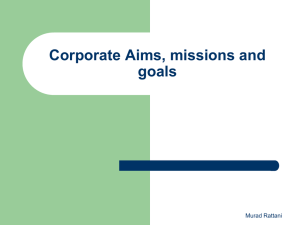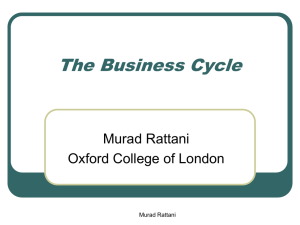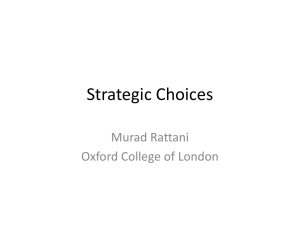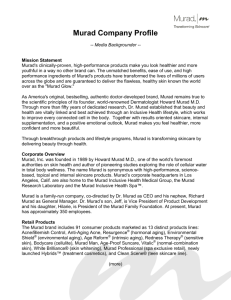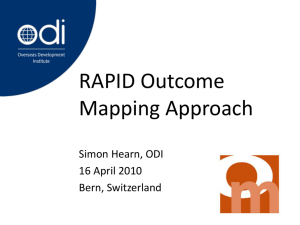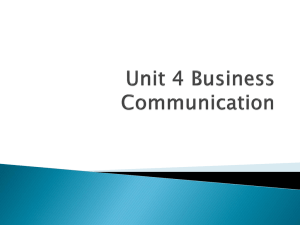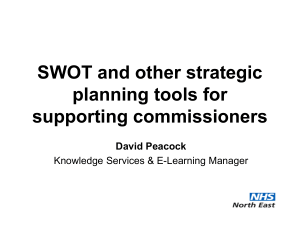Developing a strategy
advertisement
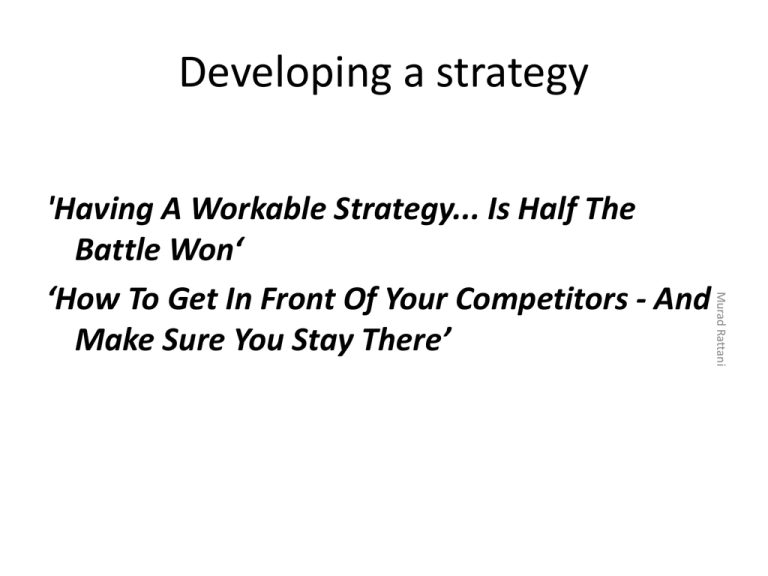
Developing a strategy
Murad Rattani
'Having A Workable Strategy... Is Half The
Battle Won‘
‘How To Get In Front Of Your Competitors - And
Make Sure You Stay There’
Strategy
Johnson and Scholes define strategy as follows:
• "Strategy is the direction and scope of an organisation over the long-term:
which achieves advantage for the organisation through its configuration
of resources within a challenging environment, to meet the needs of
markets and to fulfil stakeholder expectations".
Murad Rattani
Strategy is about
•
Where is the business trying to get to in the long-term (direction)
•
Which markets should a business compete in and what kind of activities are
involved in such markets? (markets; scope)
•
How can the business perform better than the competition in those markets?
(advantage)?
•
What resources (skills, assets, finance, relationships, technical competence,
facilities) are required in order to be able to compete? (resources)?
•
What external, environmental factors affect the businesses' ability to compete?
(environment)?
•
What are the values and expectations of those who have power in and around the
business? (stakeholders)
Murad Rattani
Strategy at Different Levels of a Business
Strategies exist at several levels in any organisation - ranging
from the overall business (or group of businesses) through
to individuals working in it.
• Corporate Strategy - is concerned with the overall purpose and scope of
the business to meet stakeholder expectations. This is a crucial level since
it is heavily influenced by investors in the business and acts to guide
strategic decision-making throughout the business. Corporate strategy is
often stated explicitly in a "mission statement".
• Business Unit Strategy - is concerned more with how a business competes
successfully in a particular market. It concerns strategic decisions about
choice of products, meeting needs of customers, gaining advantage over
competitors, exploiting or creating new opportunities etc.
• Operational Strategy - is concerned with how each part of the business is
organised to deliver the corporate and business-unit level strategic
direction. Operational strategy therefore focuses on issues of resources,
processes, people etc.
Murad Rattani
A strategic management process has
three main processes
Murad Rattani
Strategy
A strategy is a holistic view of the organization’s purpose. It is
usually expressed in terms of:
Murad Rattani
• Long term objectives
• Actions to achieve these
• Resource allocations necessary to support
them.
A strategy usually supports an over-arching ‘vision’ of the future,
linked to a mission statement. Beneath it will be detailed
plans and details.
Strategic Analysis
• This is all about the analysing the strength of
businesses' position and understanding the
important external factors that may influence
that position. The process of Strategic Analysis
can be assisted by a number of tools,
including:
Murad Rattani
Strategic Analysis
•
•
•
•
•
•
•
•
PEST Analysis - a technique for understanding the "environment" in which a
business operates
Scenario Planning - a technique that builds various plausible views of possible
futures for a business
Five Forces Analysis - a technique for identifying the forces which affect the level
of competition in an industry
Market Segmentation - a technique which seeks to identify similarities and
differences between groups of customers or users
Core Competencies- a technique which summarises the competitive strength of a
businesses operations in specific markets
Competitor Analysis - a wide range of techniques and analysis that seeks to
summarise a businesses' overall competitive position
Critical Success Factor Analysis - a technique to identify those areas in which a
business must outperform the competition in order to succeed
SWOT Analysis - a useful summary technique for summarising the key issues
arising from an assessment of a businesses "internal" position and "external"
environmental influences.
Murad Rattani
Strategic Choice
• This process involves understanding the
nature of stakeholder expectations (the
"ground rules"), identifying strategic options,
and then evaluating and selecting strategic
options.
Murad Rattani
Strategy Implementation
Often the hardest part. When a strategy has
been analysed and selected, the task is then
to translate it into organisational action.
Murad Rattani
Developing a strategy
Murad Rattani
The Vision
The vision is usually couched in very high-level
terms, eg:
The mission statement elaborates on this.
Murad Rattani
• Coca Cola wanted every customer to be able to buy its
product anywhere in the world.
• Wedgwood wanted to sell crockery to every worker.
• Henry Ford had a vision of everybody driving one of his cars.
Mission
The mission (a US term that has virtually been adopted worldwide) is a statement of what
the organization’s objectives are. It might be
•
‘To be the leading retail bank in the UK, as measured by market share, capital
strength and profitability’.
It will then go on to state the high-level ‘hows’:
Murad Rattani
•
‘We will achieve this by increasing our telephone banking service and by reducing our
branch network by: concentrating only on profitable customers; offering a
personalized service; and offering a 24-hour banking; etc’
An then state the implication of this:
•
‘We will have excellent IT support; adequate training for staff; remuneration linked to
performance; etc.’
It is within this framework that strategies and policies are set.
A mission must be
• Market focussed.
• Motivating.
Murad Rattani
• Based on core strengths/ competencies.
Gap Analysis
•
Company
Murad Rattani
•
Market
Gap Analysis
Murad Rattani
• This involves taking the internal analysis and
comparing it with the external analysis (from
your research) to see how your company
measures up and what is missing if you are to
meet your objectives.
• Once this gap analysis has been carried out,
you then need to take steps to close the gap.
• Selective benchmarking can often be of use
here.
Gap Analysis
• You only close the gaps where the action required will deliver
substantial dividends, where it is cost-effective or where it is a
fundamental issue.
Murad Rattani
• The objective is to make your products acceptable in your
target segments and, ideally, to make them more effective
than your competitors’. For example, there has recently been
an increase in the number of car manufacturer offering offroad vehicles and ‘people carriers’, reflecting the growing
demand for these products.
Developing new products and services
Murad Rattani
• Research/gap analysis might indicate that there are gaps between
what you are offering and either what your competitors are offering
or what your customers need and demand-or both.
• In this event, you need to develop new products, or improve your
existing ones, to fill the gaps. This can take time depending on the
nature of your business and must be factored into your planning
and timing.
• Where products have a long lead time (eg: pharmaceuticals,
aerospace industry) then you will need to develop an interim
strategy until your new products are ready, and a further strategy to
capitalise on these.
• Depending on your industry, you may need to develop new
internet-specific products and services, which may contain different
features (often simpler/cheaper) from those offered via more
traditional channels.
Management Strategy
Different approaches to strategy
Uses of strategy
General environment of the organization
Immediate competitive environment of the organization
Murad Rattani
What is management strategy
Murad Rattani
Management strategy is a linking process
between organizational variables and the
environment. It seeks strategic fit between
organization and its environment.
Elements of Management strategy
Murad Rattani
• Involves consideration of environmental
changes which bring new opportunities and
threats.
• Concerned with assessment of internal
strengths and weaknesses of the institution
and using those exploiting opportunities and
averting threats.
Steps to setting-up
Analyse the environment (PEST)
Analyse the industry (Michael Porter’s five forces)
Analyse the markets (segmentation)
Analyse your company (organizational audit) {SWOT, BCG}
Conduct gap analysis (what is missing/poor) (weaknesses)
Conduct stakeholders’ analysis
Develop products where appropriate.
Evaluate the strategies
Undertake planning
Implementation
Murad Rattani
•
•
•
•
•
•
•
•
•
•
Environmental Analysis
(PEST Analysis)
Market Analysis
Competitive position Analysis
(BCG, Michael Porter’s 5 forces
(identify players)
Organizational audit (Resource
analysis, SWOT, Gap Analysis, FFA )
Stakeholders’ Expectation
analysis
Strategy Planning and
Implementation
Murad Rattani
Strategy evaluation
Uses and value of strategy
Murad Rattani
• Helps in formulation of goals and objectives and enables them
to be modified in the light of experience and information.
• It is a form of management control. A plan that guides
behaviour along a predetermined route. At the operational
level it results in budgets and targets.
• Helps in allocation of resources and provides logic so that
allocation of resources is perceived to be fair by the whole of
organization.
Uses and value of strategy
Murad Rattani
• Helps the firm to identify key strategic issues that the firm
may face in the future and design appropriate actions.
• Helps in guiding the action of different departments of the
firm and integrates their actions.
• Helps in social change as strategy can be implemented by
training and modifying the behaviour of the employees and
the managers.
Environmental aspects of strategy
Murad Rattani
• General environment: it affects all the firms
operating in a given business environment. It
includes PEST.
• Immediate competitive environment: This has
got direct bearing on the firm’s competitive
position.
Analysis of both these environments will help the
managers to assess the opportunities and
threats for the firm.
General environment
Murad Rattani
Johnson and Scholes, 2002 has classified the general
environment as follows;
Simple and static: in this scenario, strategy could be designed
with the help of historical data and past records.
Dynamic: manager should be sensitive to changes in the
environment but should not over react.
Complex: this environment is faced by firms who deal with wide
range of product assortments. It can lead to divestment,
mergers or acquisitions.
Dynamic and complex environments
Murad Rattani
In case of dynamic and complex environments, firms may face
various problems which could be resolved by
Collecting relevant information.
Responding to environment by technological innovation,
coalition with other organizations by merger, takeovers,
political lobbying, acquiring raw materials i.e. suppliers or
retail outlets, training staff and so on.
New divisions or departments could be formed to deal with the
competition.
References
• http://tutor2u.net/business/strategy/what_is
_strategy.htm
• www.marketingteacher.com/.../lesson_ansoff.
htm (accessed on 19-11-09)
Murad Rattani
Further reading
David Needle, 2004, Business in Context, An
introduction to business and its environment
(ISBN: 978-1-86152-992-3), pgs: 754-756
Ian Marcouse, The Business Studies Teachers’
Book (ISBN: 0340-73763-8), 1999
Murad Rattani

